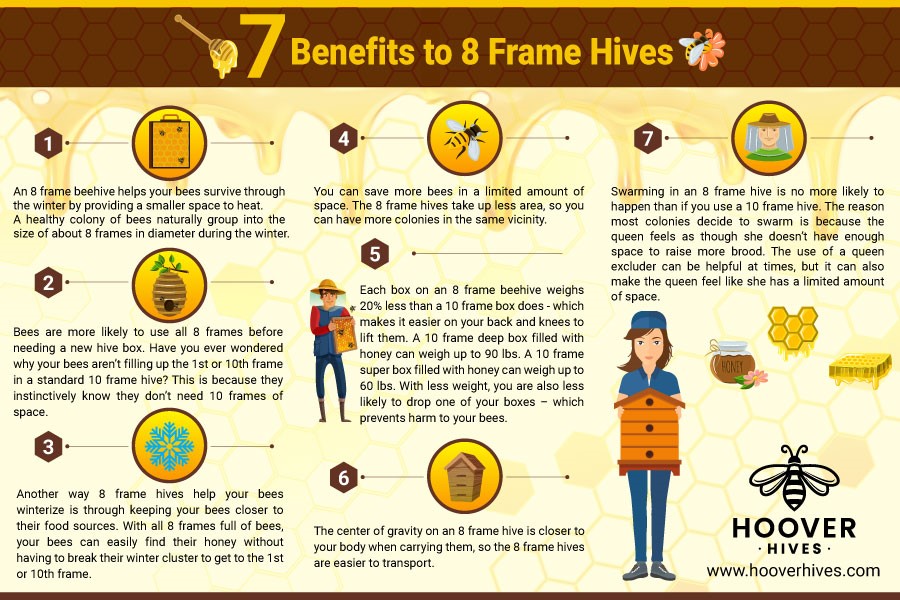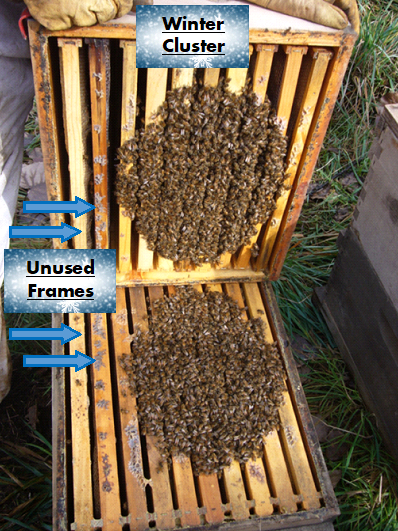7 BENEFITS TO 8 FRAME HIVES
Since 1852, the 10-Frame Langstroth beehive has been America’s standard for beekeepers. But more often than ever people are realizing that what makes something the standard doesn’t necessarily make it the best.
The 10-Frame beehive has solidified its place in history, but now there’s a smaller, easier to handle hive that costs a bit less out of pocket.
Here are 7 solid reasons why you might choose an 8-Frame hive over the traditional 10-frame Langstroth hive.
Table of contents
Survive the winter with a smaller space to heat
Bees use 8 frames before needing a new hive box
Winterize better with closer food sources
Save more bees in a limited amount of space
Avoid injury: 8 frame beehives weigh 20% less
8 frame hives are easier to carry to where you harvest
Swarming in an 8 frame hive isn’t any more likely

Survive the winter with a smaller space to heat
An 8 frame beehive helps your bees survive through the winter by providing a smaller space to heat.
A healthy colony of bees naturally group into the size of about 8 frames in diameter during the winter – take a look at the photo on the right.
If your hive contains 2 extra frames, then your bees have to use more energy to heat the extra area.
This is one of the many reasons most experts harvest before fall.
So that when the winter comes, there are less boxes on top of the hive that the bees would have to heat.
Bees use 8 frames before needing a new hive box
Bees are more likely to use all 8 frames before needing a new hive box.
Have you ever wondered why your bees aren’t filling up the 1st or 10th frame in a standard 10 frame hive?
This is because they instinctively know they don’t need 10 frames of space. The bees naturally choose to utilize 8 frames before moving vertically unless it’s a year with heavy flow.
Bees would much rather move vertically up the hive boxes than from frame to frame within the same box.
Winterize better with closer food sources
Another way 8 frame hives help your bees winterize is through keeping your bees closer to their food sources.
With all 8 frames full of bees, your bees can easily find their honey without having to break their winter cluster to get to the 1st or 10th frame.
Keeping the cluster together is essential for trapping in the heat that they have worked hard to produce.
Save more bees in a limited amount of space
You can save more bees in a limited amount of space.
The 8 frame hives take up less area than the standard 10 frame hives. This means you can have more colonies in the same amount of area.
Avoid injury: 8 frame beehives weigh 20% less
Each box on an 8 frame beehive weighs 20% less than a 10 frame box does – which makes it easier on your back and knees to lift them.
This can be a huge benefit if you’re a beginner and you’re trying to prevent long term back and knee pain. This is even better for those who have 30+ hives and spend most the day picking up these heavy boxes.
A 10 frame deep filled with honey can weigh up to 90 lbs. A 10 frame super filled with honey can weigh up to 60 lbs. With less weight, you are also less likely to drop one of your boxes – which prevents harm to your bees.
8 frame hives are easier to carry to where you harvest
The center of gravity on an 8 frame hive is closer to your body when you’re carrying them so the 8 frame hives are easier to transport.
Regardless of if it’s while you’re choosing a spot in your yard for your new apiary, or if your moving your hives across the state to your next almond orchard. This center of gravity being closer to your body makes it less likely that you will drop your hive boxes while transporting.
Swarming in an 8 frame hive isn’t any more likely
Swarming in an 8 frame hive is no more likely to happen than if you use a 10 frame hive.
The reason most colonies decide to swarm is because the queen feels as though she doesn’t have enough space to raise more brood.
The queen excluder can be helpful at times. But, it can also make the queen feel like she has a limited amount of space.
Make sure she feels like she has enough space and swarming won’t be an issue.


Very Nice… several of these reasons are why I choose 8 frame hives…